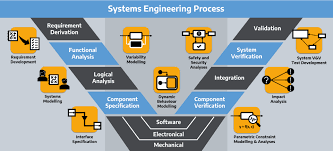Model-Based Systems Engineering & Software Engineering for Full-Stack IoT & ML in DER
Executive Summary:
This white paper explores the critical role of Model-Based Systems Engineering (MBSE) and robust Software Engineering (SE) practices in the development and deployment of full-stack IoT and Machine Learning (ML) solutions for Distributed Energy Resources (DER) in the evolving energy landscape. It highlights the challenges and opportunities presented by this convergence and provides a roadmap for successful implementation, including relevant use cases, tool recommendations, and best practices.
1. Introduction
The energy sector is undergoing a profound transformation, driven by the rapid growth of renewable energy sources, the rise of distributed energy resources (DERs), and the increasing integration of digital technologies. This shift necessitates a paradigm shift in engineering approaches to address the complexity of these interconnected systems.
2. The Need for MBSE and Robust SE
- Increasing Complexity:
- The integration of DERs (solar, wind, storage, EVs) with the grid introduces significant complexity, requiring a holistic view of the entire system.
- IoT devices, edge computing, and cloud platforms generate massive amounts of data, demanding efficient data management and analysis.
- ML algorithms for forecasting, optimization, and control add another layer of complexity to the system.
- Need for Collaboration:
- Successful DER integration requires collaboration among various stakeholders: utilities, grid operators, DER owners, and system integrators.
- MBSE provides a common language and framework for all stakeholders to understand and communicate system requirements, design decisions, and operational constraints.
- Time-to-Market & Cost Optimization:
- Traditional engineering approaches can be time-consuming and costly, especially for complex systems.
- MBSE and automated software development can accelerate development cycles, reduce risks, and improve overall project efficiency.
3. Key Concepts and Technologies
- MBSE:
- Focus: System-level thinking, early identification of risks, and improved communication.
- Key Concepts:
- Systems Thinking: Holistic view of the entire system, considering interactions and dependencies.
- Model-Driven Development: Using models as the primary source of truth for system design and implementation.
- Systems Modeling Language (SysML): A graphical language for specifying, analyzing, designing, and verifying complex systems.
- Software Engineering:
- Focus: Building high-quality, maintainable, and scalable software solutions.
- Key Concepts:
- Agile Development: Iterative and incremental development with a focus on customer collaboration.
- DevOps: Continuous integration and continuous delivery for faster software releases.
- Microservices Architecture: Breaking down complex systems into smaller, independent services.
- IoT & ML:
- IoT: Enables real-time data collection, monitoring, and control of DERs.
- ML: Enables predictive maintenance, demand response, and optimized grid operations.
4. Use Cases
- Predictive Maintenance of DERs:
- MBSE: Model the health and performance of DER components (e.g., solar panels, batteries).
- SE: Develop software for data acquisition, analysis, and anomaly detection.
- ML: Train models to predict equipment failures and schedule maintenance proactively.
- Grid Integration and Stability:
- MBSE: Model the impact of DERs on grid stability, including voltage fluctuations and frequency deviations.
- SE: Develop software for real-time grid monitoring and control algorithms.
- ML: Train models to predict and mitigate grid instability issues caused by DER fluctuations.
- Demand Response and Load Management:
- MBSE: Model customer preferences, energy consumption patterns, and DER capabilities.
- SE: Develop software platforms for demand response programs, such as dynamic pricing and load shifting.
- ML: Train models to forecast energy demand and optimize DER dispatch for peak load shaving.
- Microgrid Optimization:
- MBSE: Model the interactions between different DERs within a microgrid (e.g., solar, wind, storage, and on-site generation).
- SE: Develop software for energy management and control systems.
- ML: Train models to optimize energy production, consumption, and storage within the microgrid.
5. Tools and Technologies
- MBSE Tools:
- Cameo Systems Modeler: A popular tool for SysML modeling and simulation.
- MagicDraw: Another comprehensive MBSE tool with strong SysML support.
- Software Development Tools:
- Git: Version control system for collaborative software development.
- Jenkins/GitLab CI/CD: Tools for continuous integration and continuous delivery.
- Docker/Kubernetes: Containerization and orchestration platforms for deploying and managing microservices.
- IoT Platforms:
- AWS IoT, Azure IoT, Google Cloud IoT: Cloud-based platforms for IoT data management and analysis.
- ML Frameworks:
- TensorFlow, PyTorch: Popular frameworks for developing and deploying machine learning models.
6. Best Practices
- Early Stakeholder Involvement: Involve all stakeholders (utilities, regulators, customers) throughout the development process.
- Iterative Development: Adopt an iterative approach to development, allowing for continuous feedback and improvement.
- Data Quality and Security: Ensure high-quality data collection and robust cybersecurity measures.
- Continuous Learning and Improvement: Continuously monitor and evaluate system performance and make necessary adjustments.
7. Conclusion
The integration of MBSE, robust SE, IoT, and ML is crucial for the successful development and deployment of innovative DER solutions. By adopting these approaches, energy companies can:
- Improve system reliability and resilience.
- Reduce operational costs and enhance efficiency.
- Accelerate the transition to a clean and sustainable energy future.
8. References
- [1] INCOSE Systems Engineering Handbook
- [2] OMG SysML Specification
- [3] Agile Manifesto
- [4] DevOps Handbook
- [5] Books and articles on IoT, ML, and related technologies
Disclaimer:
This white paper provides a general overview of the topic. Specific implementations and best practices may vary depending on the specific project requirements and constraints.
Note: This is a general framework. You would need to adapt it with specific details, case studies, and tool recommendations relevant to the DER industry and the target audience (CEO and CTO).
This information is for general knowledge and informational purposes only. For specific advice or guidance, consult with qualified professionals. Submit your RFP to ias-research.com



